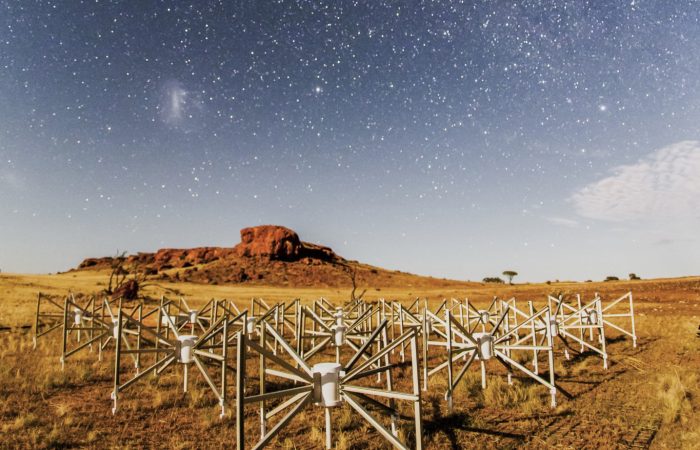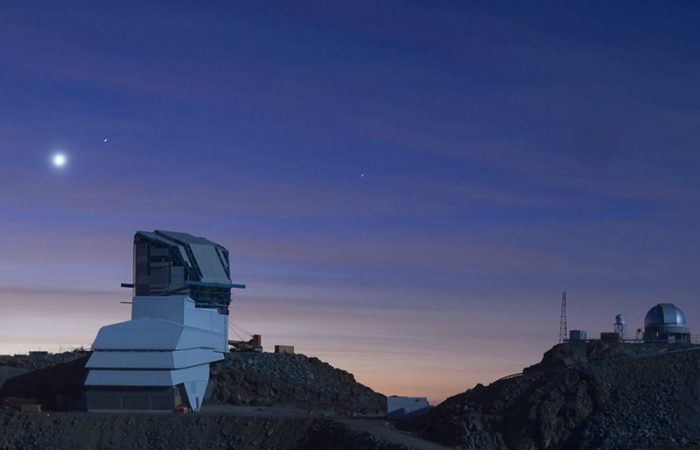Other AAL-supported projects with successes this past year include the Australian Square Kilometre Array Pathfinder (ASKAP). January 2022 was marked by the first data release of ASKAP SWAG-X, with multi-wavelength coverage of the GAMA-09 equatorial sky region. SWAG-X was initiated as a complementary ASKAP survey to the eROSITA X-ray and the GAMA-09 spectroscopic observations at the Anglo-Australian Telescope (AAT) to contribute to studies of cosmology, galaxy formation and evolution. See the full story here.
In July 2021, an international collaboration of astronomers and telescopes also revealed new imagery of galaxies moving at high speed, headed for an intergalactic collision. The cluster of galaxies is known as The Northern Clump, which was imaged for the first time with unprecedented detail at x-ray, visible and radio wavelengths. SRG/eROSITA, XMM-Newton and Chandra satellites were involved in creating this and other images, along with DECam optical data and CSIRO’s ASKAP radio telescope.
AAL is proud to support ongoing operations of CSIRO’s ASKAP telescope, and development of the CSIRO ASKAP Science Data Archive (CASDA), via NCRIS. AAL is also proud to represent all astronomers involved with the eROSITA project at Australian institutions via the agreement that made this collaboration possible, signed between AAL and the German eROSITA Consortium (eROSITA_DE).
For more on AAL-supported projects, please visit the “What we do” section of this website.
Industry Engagement
In 2021/22 AAL’s industry engagement program expanded and changed focus. Whereas in previous years AAL had focused on promoting existing commercialisation efforts, in the 2021/22 period AAL shifted to actively advising and assisting departments or individual teams to prioritise activities. This was largely done with the collaboration of commercialisation expert Dr Ilana Feain. AAL’s goal has been to encourage a more systematic process in regard to the commercialisation of Australian astronomy technology. This work is being achieved against a background of increasing government focus on realising the commercial benefits of scientific research.
Throughout 2021/22, AAL also expanded its website to showcase more success stories, capabilities and commercialisation activities of Australian astronomers. A selection of the projects we feature on the site are listed below (or see our special highlights story in the ‘Projects’ section above):
AAL Operations
Despite the disruption and uncertainty that COVID-19 continued to bring to AAL’s workplaces, AAL staff again performed incredibly well during the 2021/22 financial year. Since the easing of restrictions, AAL staff have been given the choice to work where they are most productive, with most continuing to work from home. The majority of AAL’s interactions have also continued to take place online.
Members
AAL is proud that it has member representatives from all institutions in Australia with a significant astronomy research program. In the 2021/22 financial year there were 15 institutional members of AAL. Each member organisation has a nominated representative who attends the Annual General Meeting (AGM) to elect Board Directors. Member representatives are also consulted throughout the year on key astronomy infrastructure and investment decisions. To see a list of AAL representatives, please visit the “Member Institutions” page of this website.
Board
The independent, skills-based AAL Board of Directors comprises seven individuals with expertise in astronomy, management and finance. The board is responsible for the overall governance and strategic direction of AAL. They make key decisions about projects based on the recommendations of advisory committees, their own considerable and diverse expertise, and with consideration of the priorities and recommendations in the Decadal Plan. To see current AAL Board members, please visit the “Board of Directors” page of this website. For a list of AAL Board members current over the 2021/22 period, see the following list. Click on the names below to see a biography for each director:
Committees and External Representatives
AAL’s two advisory committees: the Science Advisory Committee (ASAC) and Project Oversight Committee (APOC) – continue to play an important role in ensuring the relevance and quality of AAL’s programs. Committee members are appointed to provide the relevant breadth of expertise, and an appropriate mix of gender, seniority and institutional diversity. AAL’s advisory committees provide strategic advice to the AAL Board in implementing the infrastructure priorities of the Decadal Plan, and support AAL in oversight of, and promoting improved outcomes for, AAL-funded projects. AAL also maintains a number of resource allocation committees, and an Industry Engagement Working Group. For more information, please visit the “AAL Committees” page of this website.
As well as these internally managed groups, AAL appoints astronomers to external boards and committees. AAL then provides support to these appointees to represent the interests of Australian astronomers nationally and internationally. For more information, please visit the “External Representatives” page of this website.
Equity, Diversity and Values
AAL has a long-standing commitment to equity and diversity. AAL’s employment philosophy is open and flexible, with a mix of full and part-time positions. It matches work modes with situations and needs, aiming to combine the best of office-based and virtual work, and having regard to the work/life balance and individual needs of AAL’s staff. With a responsibility for determining representation on a variety of external bodies related to astronomy, as well as membership of its advisory committees, AAL has a selection process for all these positions that addresses principles of inclusion and gender balance.
AAL’s values statement reflects AAL’s desire to consider the environment in its everyday operations while maintaining our existing emphasis on upholding respectful interactions with all people.
AAL endeavours to be an environmentally sustainable organisation built upon equity, diversity and mutual respect for its staff and stakeholders.
For more information, please visit the “Environmental, Social and Governance” page of this website.






